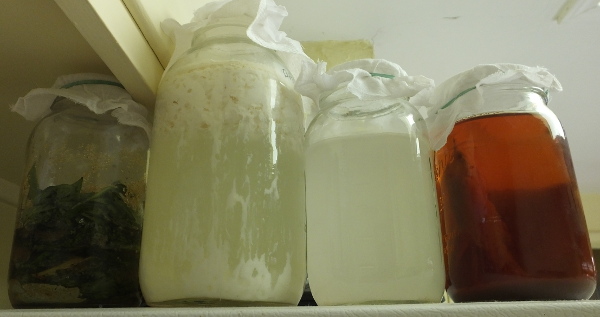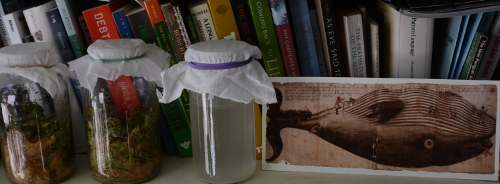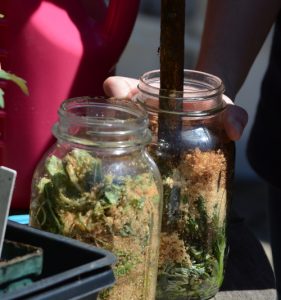Should My Garden Lactos Bacilli Smell Like Cheese?

I use LAB primarily in the chickens' water, their bedding, the compost pile and my garden's soil. It's versatile. The large jar I made last year is almost finished, so it is time to make some more, and to introduce it. LAB is one of the easiest Korean Natural Farming (KNF) inputs to make, so maybe that's why I forgot to write it up. But it's a fascinating input.
This is how I make LAB
- After I've soaked rice in non-chlorinated water for making IMO for 24 hours, I pour off the water into a jar. I sterile all jars, utensils and my hands with vinegar. I put a paper towel over it so it can attract the lactic acid bacteria (LAB) from the air, and so that it can vent. This rice water is nutrient poor, so only the strongest bacteria will colonize it and thrive.
- After a week or so (it depends on temperature), the lactic acid bacteria start to propagate and start to give off a sour smell (this is the lactic acid, which has a PH of 2). At that point you add 1 part of the sour water to 10 parts whole milk (organic is best, as antibiotics in the milk will kill the bacteria). Milk is nutrient-rich, so the bacteria will have a feast!
- In about five days there is a separation between the curds (which float on top) and the whey, a yellow liquid (remains at the bottom). The liquid is the lactic acid with the LAB in it. Once the separation is complete, carefully scoop out the curds – make them into cheese, or feed them to the chickens (they too love it). Keep the LAB liquid in the fridge, where they will keep for months.
How does it work?
- YeastsÂ(which are fungi, not bacteria) consume sugars (carbohydrates) and produce alcohol. Hence beer, wine, mead… Bacteria also consume sugars and starches (carbohydrates), but they produce acids. Some of these bacteria also consume alcohol. My favorite, acetobacter, thrives in the air and if it gets its hands on your brew, it will convert it into acetic acid… vinegar! That's why you want an airlock on your carboy, to let the carbon dioxide bubbles that the yeasts produce escape, but to keep acetobacter out. (*) Acetic acid preserves food by lowering the pH (raising the acid level) and making an environment that is unfriendly to harmful bacteria.
- But with the rice starch we washed off into the water we are catching a different set of bacteria. L actic Acid Bacteria (LAB) too are readily available in the air (should that surprise anyone?). As they digest carbohydrates (sugars, starches, etc.), they produce lactic acid. This process is called lacto-fermentation, which is usually anaerobic (not open to the air). This lactic acid is what produces the sour flavor in yogurt, raw lacto-fermented pickles, sauerkraut, etc.
- As the LAB go to town on the sugars in the milk, the rising acidity causes the milk proteins (casein) to tangle into solid masses, the curds. The remaining liquid, the whey, contains only whey proteins. In cow's milk, 80% of the proteins are caseins, 20% are whey. Human milk, by the way, is 60% whey and 40% casein. The LAB themselves are present mostly in the whey.
- In the fridge, the LAB go to sleep (it's too cold for them, plus you're not feeding them anymore). When you take them out and add them to drink water or spray them on manure or soil, they wake up again, start feeding, and multiply.
- You can pair up LAB with other organisms in AEM (Activated Essential Micro Organisms). More on that here and here.
What is it good for?
- For animals, LAB are nutritious. They make B Vitamins, Vitamin K2 and enzymes in fermented foods – all good things. LAB are also probiotic.. When you eat them (alive, as you should eat them), you are adding beneficial life forms to your digestive tract. Also, the lactic acid lowers the PH in the gut, and the other the beneficial life forms there like it acidic. Thus the thriving beneficials will crowd out the non-beneficials.
- For plants, it's the same. But where is the plant's gut? It's its rhizosphere, the soil all around its roots, and its phyllosphere, its leaf and stem surface. So just as we introduce probiotic organisms into our gut with yogurt, we should introduce probiotics into the plant's guts by adding it to the soil and spraying it onto its leaves.
What do these LAB do for animals and plants?
- Being probiotic to beneficials, lactic acid is also antibiotic to non-beneficial organisms. Its PH of 2 inhibits salmonella and e. coli. and most Gram-positive organisms including spore-formers such as Clostridia Botulinum and heat-resistant spoilage organisms"Â (more on that here).
- LAB also keep a check on the alcohol-producing yeasts. Yeasts are anaerobes that make alcohol. We don't want alcohol in our soil because it kills (most of that antimicrobial hand wash is alcohol, which dries out the protective cell walls of most organisms).
- We don't want an anaerobic soil because the pathogenic organisms are predominantly anaerobic (more about that here). Also, roots need oxygen. LAB are facultative anaerobes. In aerobic conditions they breathe in oxygen, in anaerobic conditions they ferment and start bubbling (just like yeasts bubble inside baking bread), which creates pore spaces, which can then fill up with oxygen. So they ventilate a soil that is about to go anaerobic, and help a soil that already is.
- While they do this, they also eliminate bad odors. Usually, if it smells bad, it's bad. The foul odor in a compost pile is due to anaerobic decomposition, which gives off corrosive ammonia. Better not breathe that in too deeply. Same in the chicken coop: if it smells like ammonia, the bedding is too loaded with manure, or too wet. You can fluff up the compost pile, or change the bedding, but you could also try spraying some LAB. The LAB feed on ammonia. I use LAB in my coop, and they are also sprayed on pig stalls, smelly sports shoes, etc. So waste becomes food.
- As part of the plant's gut, LAB digest minerals that are not easily dissolved, making them available in a form plants can absorb.
- If you use it to lactoferment animal feed (more here), that feed is already pre-digested, making it easier to digest, and it will add the probiotics to the animals' gut. I would not feed only fermented grains to hens, because the bacteria in the gut need to do the work too. A healthy mix is best. Same for plants. You eat yogurt and you know it's good for you. Let's put aside this notion that humans are so different from chickens, and that animals are so different from plants. All should get a healthy dose of probiotics!
How to use
- Foliar spray
- Soil drench
- In animal water
- In animal feed (more on fermented chicken feed here)
- In animal bedding
- Spray on compost pile
- Clear clogged drains and keep the septic organisms happy
(*) When brewing kombucha you're playing with the yeast-bacteria balance. Kombucha is the output of a SCOBY – a Symbiotic Community of Bacteria and Yeasts. The yeasts make alcohol and carbon dioxide, which makes the kombucha bubbly, and the alcohol is immediately consumed by acetobacter, was turns the liquid sour. Too much yeast, and your kombucha turns alcoholic. Too much acetobacter, and it becomes too acidic, killing all the life in it and stopping the ferment.
||||
Today I also gathered the meristems of the fast-growing weeds I could find for another batch of Fermented Plant Juice (FPJ). I still have half a jar from last year, and one dilutes a lot when using it (1000:1 or 500:1), but it's good to look ahead. Also, this is time when the nettles and comfrey are at that super-growth-hormonal stage.


Should My Garden Lactos Bacilli Smell Like Cheese?
Source: https://blog.bolandbol.com/2017/04/24/more-knf-introducing-the-fabulous-lab-lactic-aid-bacteria/
Posted by: broadwateruterming.blogspot.com

0 Response to "Should My Garden Lactos Bacilli Smell Like Cheese?"
Post a Comment